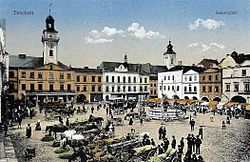Teschen District (German: Politischer Bezirk Teschen, Czech: Politický okres Těšín, Polish: Powiat polityczny Cieszyn) was a political district (equivalent to okres in the Czech Republic and powiat in Poland) in Austrian Silesia of the Austrian Empire (and since 1867 of Austria-Hungary) existing between 1850–1855 and 1868–1920. Its administrative center was the city of Teschen (now Cieszyn, Poland and Český Těšín, Czech Republic).
Teschen District | |
|---|---|
 | |
 |
History
editRevolutions of 1848 in the Austrian Empire led to various social, legal and also administrative reforms. In late December 1849, Austrian Silesia was re-established and was initially subdivided into seven political districts, including one with the seat in Teschen. Political districts were additionally divided into legal districts (German: Gerichtsbezirk). Teschen political district consisted at the beginning of three legal districts: Teschen, Freistadt (Czech: Fryštát, Polish: Frysztat) and Jablunkau (Czech: Jablunkov, Polish: Jabłonków).[1] In the era of Bach's neo-absolutism political districts were abolished and replaced by district offices (German: Bezirksamt) encompassing territories of the abolished legal districts. Political districts were re-established in 1868. Teschen political district was reshaped to include legal district of Friedek (before 1855 a separate political district) whereas Freistadt legal district was excluded to form the new Freistadt political district.[1]
In 1880 Teschen political district was administratively divided into 101 municipalities (49 in Teschen legal district, 32 in Friedek, 20 in Jablunkau).[2] Until 1890 this number grew to 102 (Žermanice were separated from Horní Bludovice) and on 1 January 1890 to 103 (separation of Lomná into Dolní Lomná and Horní Lomná). On 1 October 1901 Friedek legal district (with 33 municipalities) was excluded to form the re-established Friedek political district.[3] After this Teschen political district had an area of 730 km2, 70 municipalities (49 in Teschen legal district and 21 in Jablunkau).[4]
According to the censuses conducted in 1880, 1890, 1900 and 1910 the population Teschen and Jablunkov legal districts were as follows:[5]
| 1880 | 1890 | 1900 | 1910 | |
|---|---|---|---|---|
| Teschen legal district | 51,099 | 54,663 | 62,044 | 71,809 |
| Polish-speaking | 34,551 (69.1%) | 39,258 (73.6%) | 42,380 (70,2%) | 47,982 (68,3%) |
| Czech-speaking | 7,536 (15.1%) | 4,912 (9,2%) | 5,320 (8,8%) | 6,033 (8,6%) |
| German-speaking | 7,869 (15,8%) | 9,150 (17.2%) | 12,583 (20,9%) | 16,133 (23%) |
| Jablunkau legal district | 24,413 | 26,738 | 28,987 | 30,743 |
| Polish-speaking | 24,371 (97,5%) | 25,607 (97.4%) | 27,614 (97%) | 26,165 (96,4%) |
| Czech-speaking | 93 (0,4%) | 63 (0.2%) | 86 (0.3%) | 171 (0,6%) |
| German-speaking | 538 (2,1%) | 622 (2,4%) | 773 (2,7%) | 912 (3%) |
Traditionally the territory of those two legal districts was inhabited by Cieszyn Vlachs in the north and Silesian Gorals in the south, speaking Cieszyn Silesian and Jablunkov dialects. The results of those censuses and factors shaping national identity of the local population became a perennial subject of the political squabbles in the region.[6] Additionally in terms of religion in 1910 the population with permanent residence consisted of Roman Catholics (56,924 or 55.5%), Protestants (42,738 or 41.7%), Jews (2,689 or 2,6%) and 201 others.[7]
After World War I and fall of Austria-Hungary the region of Cieszyn Silesia including the territory of Teschen political district became disputed land between Czechoslovakia and Poland. This led to Polish–Czechoslovak War and the division of the region and district on 28 July 1920, by a decision of the Spa Conference. The part of Teschen district that was found within Czechoslovakia was superseded by Český Těšín District whereas the other part found in Poland was replaced by Cieszyn County, that was enlarged by municipalities of Freistadt and Bielitz districts.
Municipal division
editAs of 1910:[4]
- Jablunkau legal district (Gerichtsbezirk Jablunkau)
- Bistrzitz
- Boconowitz
- Bukowetz
- Grudek
- Istebna
- Jablunkau (town)
- Jaworzinka
- Karpentna
- Koniakau
- Koszarzisk
- Lischbitz
- Unter Lomna
- Ober Lomna
- Millikau
- Mosty
- Nawsi
- Niedek
- Oldrzychowitz
- Piosek
- Tyra
- Wendrin
- Teschen legal district (Gerichtsbezirk Teschen)
- Bażanowitz
- Nieder Bludowitz
- Bobrek
- Brzezuwka
- Nieder Dattin
- Dobratitz
- Nieder Domaslowitz
- Ober Domaslowitz
- Dzingelau
- Kameral Ellgoth
- Grodischcz
- Gumna
- Gutty
- Haslach
- Hnojnik
- Kojkowitz
- Konskau
- Kotzobendz
- Krasna
- Nieder Lischna
- Ober Lischna
- Mistrzowitz
- Mönichhof
- Mosty
- Niebory
- Ogrodzon
- Pastwisk
- Pogwisdau
- Punzau
- Roppitz
- Rzeka
- Schibitz
- Schöbischowitz
- Schumbarg
- Smilowitz
- Stanislowitz
- Teschen (town)
- Nieder Tieritzko
- Ober Tierlitzko
- Nieder Toschonowitz
- Ober Toschonowitz
- Trzanowitz
- Trzynietz
- Trzytiesch
- Wielopoli
- Zamarsk
- Nieder Zukau
- Ober Zukau
- Zywotitz
References
edit- ^ a b Janusz Gruchała; Krzysztof Nowak (2013). Śląsk Cieszyński od Wiosny Ludów do I wojny światowej (1848–1918). Cieszyn: Starostwo Powiatowe w Cieszynie. pp. 12–13. ISBN 978-83-935147-3-1.
- ^ Piątkowski, Kazimierz (1918). Stosunki narodowościowe w Księstwie Cieszyńskiem (in Polish). Cieszyn: Macierz Szkolna Księstwa Cieszyńskiego. p. 4.
- ^ Piątkowski, Kazimierz (1918). Stosunki narodowościowe w Księstwie Cieszyńskiem (in Polish). Cieszyn: Macierz Szkolna Księstwa Cieszyńskiego. p. 5.
- ^ a b Ludwig Patryn, ed. (1912). Die Ergebnisse der Volkszählung vom 31. Dezember 1910 in Schlesien (in German). Troppau.
{{cite book}}: CS1 maint: location missing publisher (link) - ^ Piątkowski, Kazimierz (1918). Stosunki narodowościowe w Księstwie Cieszyńskiem (in Polish). Cieszyn: Macierz Szkolna Księstwa Cieszyńskiego. pp. 12, 72–75.
- ^ Janusz Gruchała; Krzysztof Nowak (2013). Śląsk Cieszyński od Wiosny Ludów do I wojny światowej (1848–1918). Cieszyn: Starostwo Powiatowe w Cieszynie. p. 20. ISBN 978-83-935147-3-1.
- ^ Piątkowski, Kazimierz (1918). Stosunki narodowościowe w Księstwie Cieszyńskiem (in Polish). Cieszyn: Macierz Szkolna Księstwa Cieszyńskiego. p. 57.